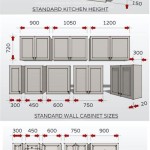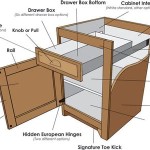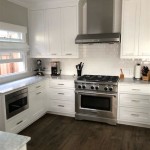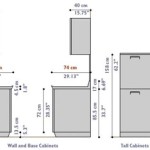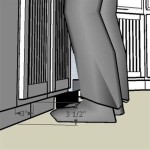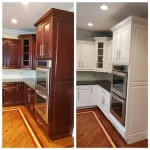How to Coordinate Kitchen Cabinets With Your Appliances
Creating a cohesive and aesthetically pleasing kitchen design requires careful consideration of all its elements. A crucial aspect of this process involves harmonizing the kitchen cabinets with the appliances. The goal is to achieve a unified look that reflects a specific design style while also maximizing functionality. This coordination necessitates understanding different appliance finishes, cabinet styles, and the interplay between them.
The selection process involves analyzing the existing or planned appliance finishes (stainless steel, black stainless steel, black, white, or custom panels) and considering how these finishes interact with various cabinet materials, colors, and textures. Matching appliances to cabinets is not about achieving an identical appearance. Rather, it is about creating a visual harmony that enhances the overall kitchen design. Thoughtful planning ensures a balance that avoids a jarring or disjointed look.
Several factors contribute to achieving this desired harmony. The kitchen's architectural style significantly influences both appliance and cabinet choices. A contemporary kitchen might favor sleek, minimalist cabinets coupled with stainless steel appliances, while a traditional kitchen could incorporate ornate cabinets in warmer tones alongside panel-ready appliances that blend seamlessly with the cabinetry. The size of the kitchen also plays a role, as smaller kitchens may benefit from lighter cabinet colors to maximize light and create an illusion of more space, and appliance choice that complements the cabinets can enhance the feeling of openness.
Understanding Common Appliance Finishes and Their Corresponding Cabinet Styles
Appliance finishes play a critical role in dictating suitable cabinet styles. Some of the most prevalent appliance finishes include stainless steel, black stainless steel, black, white, and custom panel-ready options. Each finish possesses unique characteristics that lend themselves well to certain cabinet designs.
Stainless steel appliances are a frequently chosen option due to their clean, modern appearance. They offer a versatile aesthetic that can complement a wide range of cabinet styles. Light or medium-toned wood cabinets such as maple or oak pair well with stainless steel, creating a warm and inviting contrast to the cool metal tones. White or gray cabinets are also excellent choices, providing a sleek, contemporary backdrop that enhances the stainless steel's shine. Darker cabinets, such as those made from cherry or walnut, can create a dramatic and sophisticated look when paired with stainless steel. It’s important to ensure the undertones of the cabinets and stainless steel harmonize. For instance, avoid cabinets with a very warm, yellowish undertone next to stainless steel with a cool, blue undertone.
Black stainless steel appliances offer a softer, warmer alternative to traditional stainless steel. This finish often looks best with cabinets in lighter shades. White, cream, or light gray cabinets create a bright and balanced contrast. Natural wood tones, particularly those with reddish or brown hues, also complement black stainless steel. Avoid pairing black stainless steel with very dark cabinets, as this can create a visually heavy and monotonous space. Consider the lighting in the kitchen, as the darker finish of black stainless steel can absorb light. Adequate lighting is important to ensure the cabinets and appliances remain the focal point without darkening the whole room.
Black appliances offer a bold and contemporary statement. They often work well with white cabinets, creating a classic and high-contrast look. Lighter wood cabinets, such as birch or ash, can also create a pleasing balance with black appliances. To achieve a modern and sophisticated aesthetic, consider pairing black appliances with gray cabinets. Avoid combining black appliances with dark brown or very dark-toned wood cabinets, as this can make the kitchen feel small and enclosed. Accenting with metallic hardware on the cabinets, such as stainless steel or brushed nickel, can help break up the darkness and add visual interest.
White appliances are a versatile choice that can fit seamlessly into various kitchen designs. White cabinets offer a clean, monochromatic look that is ideal for smaller kitchens, as it maximizes light and creates an illusion of spaciousness. Light-colored wood cabinets, such as maple or birch, can add warmth and texture to a kitchen featuring white appliances. For a bolder contrast, consider pairing white appliances with cabinets in pastel shades or light blues and greens. A key consideration with white appliances and cabinets is maintaining cleanliness. Regular cleaning is necessary to prevent discoloration and maintain a fresh appearance.
Custom panel-ready appliances offer the ultimate flexibility in kitchen design. These appliances are designed to accept custom panels that match the surrounding cabinetry, creating a seamless and integrated look. Panel-ready appliances are ideal for achieving a truly bespoke kitchen design. The cabinet material, color, and style can be extended across the appliances, resulting in a unified and cohesive space. This option is particularly useful in high-end kitchens where a minimalist or contemporary design is desired. While panel-ready appliances offer maximum design flexibility, they often come at a higher price point. The custom panels need to be fabricated and installed by a professional, adding to the overall cost.
Considering the Kitchen's Architectural Style
The architectural style of the kitchen significantly influences both appliance and cabinet choices. Each style has specific characteristics that dictate appropriate design elements. Understanding these characteristics is essential for creating a cohesive and harmonious kitchen space.
In contemporary kitchens, sleek lines, minimalist design, and the use of modern materials are frequently used. Stainless steel appliances are a natural fit for this style, complementing the clean aesthetic. Cabinets are typically frameless with flat panel doors, often made from materials like laminate, metal, or glass. Neutral colors, such as white, gray, and black, are frequently used in contemporary kitchens, enhancing the minimalist look. Open shelving can also be incorporated to display curated items and add visual interest. A contemporary kitchen should prioritize function without compromising style.
Traditional kitchens often feature ornate details, warm colors, and classic materials. Wood cabinets with raised panel doors are a defining feature, and common wood choices include cherry, maple, and oak. Appliance choices for traditional kitchens often involve panel-ready models that blend seamlessly with the cabinetry. If stainless steel appliances are used, they should be carefully integrated with other design elements to avoid clashing with the traditional aesthetic. Hardware typically includes antique brass or oil-rubbed bronze finishes, complementing the warm tones of the wood. Traditional kitchens aim to create a comfortable and inviting space with a timeless appeal.
Transitional kitchens strike a balance between contemporary and traditional styles, blending elements from both to create a versatile and timeless design. Cabinet choices often include shaker-style doors, which offer a clean and classic look. Appliance finishes can vary, with stainless steel and black stainless steel being popular choices. Neutral color palettes are common, with shades of white, gray, and beige dominating the space. A transitional kitchen should feel both modern and comfortable, incorporating both classic and contemporary design elements.
Farmhouse kitchens evoke a rustic and charming aesthetic, often incorporating natural materials and vintage-inspired elements. White cabinets are a popular choice, creating a bright and airy space. Wood accents, such as butcher block countertops or open shelving, add warmth and texture. Appliance choices for farmhouse kitchens often include vintage-inspired models or panel-ready appliances that blend seamlessly with the cabinetry. Apron-front sinks and rustic hardware complete the farmhouse look, contributing to a warm and inviting atmosphere. Farmhouse kitchens should feel comfortable and lived-in, emphasizing natural materials and vintage charm.
Assessing the Kitchen's Size and Lighting
The size of the kitchen and the amount of natural and artificial light it receives significantly influence cabinet and appliance choices. Proper assessment of these factors ensures that the final design enhances the space rather than overwhelms it.
In smaller kitchens, it is essential to maximize light and create an illusion of spaciousness. Light-colored cabinets, such as white, cream, or light gray, reflect light and make the kitchen feel larger. White appliances can further enhance this effect, contributing to a bright and airy atmosphere. Avoid dark cabinet colors, as they can absorb light and make the kitchen feel smaller and more enclosed. Strategic lighting, including under-cabinet lighting and recessed lighting, can help illuminate the space and reduce shadows. Consider using reflective surfaces, such as glass cabinet doors or a mirrored backsplash, to further enhance the feeling of spaciousness.
Larger kitchens offer more flexibility in terms of cabinet and appliance choices. Darker cabinet colors can be used without making the space feel cramped, and stainless steel or black appliances can create a bold and sophisticated look. Consider incorporating a mix of light and dark elements to add visual interest and depth. Island lighting is a great way to maintain the focal point of the kitchen and provide direct task lighting.
Natural light plays a critical role in the overall ambiance of the kitchen. Kitchens with ample natural light can accommodate a wider range of cabinet and appliance finishes. Darker cabinets and appliances can be used without making the space feel gloomy. Kitchens with limited natural light benefit from lighter color palettes that maximize light reflection. Additional artificial lighting, such as pendant lights or track lighting, may be necessary to brighten up the space. Consider the placement of windows and skylights and adjust cabinet and appliance choices accordingly to optimize natural light penetration.
Artificial lighting should complement the cabinet and appliance finishes to create a cohesive and inviting space. Warm-toned lighting can enhance the warmth of wood cabinets, while cool-toned lighting can enhance the sleekness of stainless steel appliances. Under-cabinet lighting is essential for providing task lighting and highlighting the countertops. Recessed lighting can provide general illumination, while pendant lights can add a decorative touch. A well-lit kitchen is not only functional but also aesthetically pleasing, enhancing the overall design of the space.
How To Match Cabinets And Appliances In Your Kitchen
Do Kitchen Appliances Have To Match In Color Proline Range Hoods
Do Kitchen Appliances Have To Match
Do Kitchen Appliances Have To Match
How To Select Appliances That Match Your Kitchen Cabinets
How To Match Kitchen Appliances With Your Home Decor Humans
Do Appliances Need To Match In Order Look Nice
How To Match Cabinets And Appliances In Your Kitchen
4 Cabinet Colors To Pair With Stainless Steel Appliances In 2024
13 Types Of Kitchen Cabinets Must Know Guide
Related Posts

